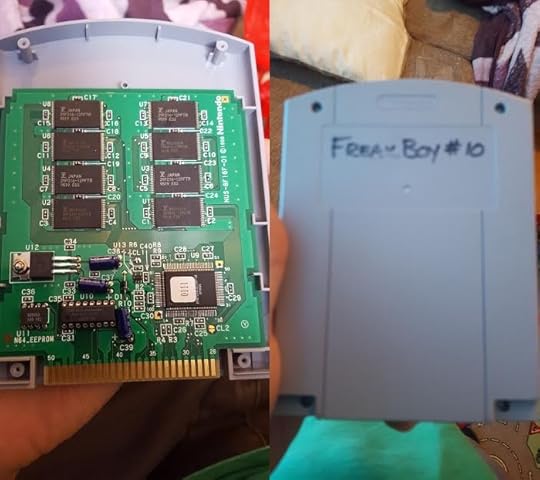Kill Screen Magazine's Blog, page 197
November 10, 2015
Awaken a neolithic civilization in Monument Valley creator's VR debut, out today
Living in the Bay Area, Land's End for me is the overly windy cliffside overlooking the chilly, probably densely-polluted San Francisco bay. For critically acclaimed Monument Valley creator Ustwo Games, Land’s End is something else entirely—a quiet, meditative VR game that was released today.
In its Samsung Gear VR debut, an ultra consumer friendly and portable VR-headset for those with Samsung phones, Ustwo Games has crafted a surreal, completely hands-free experience. With the Gear VR, Land’s End gives players the opportunity to navigate an ancient and beautiful world, said to be inspired by isolated regions from across the world, including Iceland, the Hebrides, and Saudi Arabia—and even the ancient monuments of Stonehenge.

Land’s End is somewhat of a telekinetic experience. The game itself is 100 percent hands-free, its sole interactive function being a “gaze-based” mechanic, designed by Peter Pashley and Ken Wong, making use of the Gear VR's head-tracking functionality. As you look around the wondrous landscapes of Land's End, you seek to “awaken” an ancient civilization by drawing shapes with a beam of light directed by your head movements.
somewhat of a telekinetic experience
Custom-designed for Samsung Gear VR, the intuitive gaze-mechanic and addition of more dream-like environments, like those that Monument Valley was praised for, make Land’s End a standout title on the Gear VR headset. It may even be enough to tempt your leap into virtual reality if you haven't been won over thus far.
Land’s End is out now for Gear VR for $7.99 over on the Oculus Store.
///
Feelin' like you're living in a dream after reading our coverage on videogames? Back our Kickstarter for our fancy, physical (or digital!) magazine relaunch.
Long-lost N64 game Freak Boy has been rediscovered, and it's so 1996
Videogame enthusiasts are pretty good at preserving their beloved medium’s history, even if it goes against the wishes of some industry trade groups. Emulators and ROMs, while technically piracy in most cases, allow old games that would otherwise be left to rot on cartridges or discs to live on in more durable digital formats. But that’s only when hobbyists have access to those games.
In the case of unreleased abandonware or canceled projects, there’s little hope left. That’s what makes this recent development in the story of Freak Boy, a long-canceled Nintendo 64 prototype from 1996, so exciting.

According to Unseen64, an early, but still functional prototype of Freak Boy was recently found at a flea market in Guildford, UK. While the person who purchased the cart preferred to remain anonymous, they did upload a playlist of short clips from the Freak Boy alpha. The videos depict the game being played on a television screen, but they’re still a step up from the grainy Freak Boy commercial from E3 1996, which Unseen64 identifies as the only prior footage of Freak Boy before now.
Hopefully the uploader’s request for anonymity is an indication that they hope to one day rip the prototype so people can play it; if not for the curiosity of long-time N64 owners who remember the original Freak Boy marketing, then for the sake of preservation. It’s something the people who run big-name companies in this industry should care a bit more about.
Thanks to Unseen64 and its anonymous reader for the images.
Here's a game about sexual relations with a chair to confuse and disturb you
#upholsterylove
Found footage horror continues to stutter its way into videogames
I’m a sucker for found footage films—the good, the bad, and the ugly, I’ve tried to watch them all. The same goes for horror games. So when something like The Tape comes along, a found footage-style horror game with a focus on “creating heavy atmosphere instead of cheap jump scares,” you immediately have my attention.
According to The Tape’s Steam page, the game follows a detective as he investigates a missing girl in suburban America. He’ll travel to an “abandoned house,” find a bunch of unpleasant stuff—the usual. I’m not holding out a lot of hope for the story, but I’d be lying if I said I’m not going to play the hell out of this once it’s out later this month.
the different manifestations of found footage
A few other games have managed to incorporate the concept of found footage surprisingly well. Slender: The Arrival, despite being a mediocre horror game, was faithful to the source material (most specifically, Marble Hornets) in its use of camcorder distortions to indicate Slender Man’s presence. Outlast has you play the role of a reporter, who can use his camcorder’s night vision to navigate the darkness of a run-down psychiatric hospital. Her Story is a game that asks you to piece together a murder mystery using fragments of archived footage in a police database; not traditionally “found footage,” but still interesting.
That said, The Tape’s trailers don’t make it clear in what way this is a “found footage” game aside from the grainy style. Several clips in its latest video resemble security camera footage more than home video, with lingering still shots of various rooms and hallways. It would be cool to see a game combine the different manifestations of found footage, but chances are The Tape will have you equipped with a camcorder like Slender and Outlast.
The Tape is slated for launch on November 20th. Learn more on Steam.
With Miitomo, Nintendo escapes into the real world
Nintendo isn’t making a game for your smartphone. They’re making something better.
An upcoming videogame has you explore the world with a visual scanner
Spawned from his background in photography, Ivan Notaros has come up with a beautiful way to explore a videogame world in his upcoming project Scanner. As the title reveals, it has you seeing through a first-generation robot's eyes as it ventures into a post-humanity world, constructing 3D images with a visual scanner.
Speaking during European Innovative Games Showcase at GDC Europe 2015 (in a video you can watch here), Notaros explains how he arrived upon his discovery. It all started when he began playing with photo-scanning. This is a cheaper alternative to buying a proper 3D scanning device to capture the points in a space. What it involves is taking several photographs of a central object from different angles so that you can then reconstruct the 3D space in a virtual environment.
what happened to the world in that shutdown time
Doing this, Notaros created some architecture and self-portraits that would lay the foundations of the technique behind creating Scanner. But it wasn't until he happened across an image of point clouds that had some artistic flair that the game idea formed in his mind. It was an image created using Spectroscan 3D, which is able to render shadows by coloring the points different intensities (less intense for darkness, more intense for brighter areas), meaning that every structure in the space is clearly defined and has maximum visibility.
Notaros combined this idea with his interest in capturing the past. He reasons that when you scan a 3D space you capture how it was at one particular moment in the past. This is ties in with the themes of Scanner as you play a robot that was made obsolete by the rapid advancement of robot technology that gets turned back on hundreds of years later. It's a game about finding out what happened to the world in that shutdown time by scanning its present state.
What you can see in the game's teaser is that the scanner doesn't work too fast so you get a stuttered understanding of each 3D space. Movement of an object isn't smooth, instead it's realized as several still scans of the same area taken perhaps a second apart. There can also be illusions created with the point cloud scans as a wall may seem 2D until you move to another angle to discover a 3D shape to it. At the moment, Notaros is experimenting with the potential of this idea and seeing how to make an engaging experience out of it.
our cultural obsession with the high-tech fantasies of the 1970s
But Notaros isn't alone in his ideas. Scanner is, after all, a branch of the recent rise in exploration games. And while the general direction they've been going has resulted in high-production efforts such as Everybody's Gone to the Rapture, there are more experimental offshoots. Most of these seem to be about obscuring the world that we explore so that it becomes almost like an environmental puzzle just to move around in it.

Beyond Eyes is one of these as it restricts us to smell, touch, and sound as a blind girl; the environment revealing itself as a watercolor being painted in front of us. The Unfinished Swan achieved something similar before this with its player-painted world. Then there's Memories of a Broken Dimension that also obscures its black-and-white computer world as a broken feed of a rupturing environment that requires us to fix glitches to progress.
Then there's A Light to Chorus, which is easily the most visually similar to Scanner, as it renders its world as a series of light particles that come to life. Scanner appeals more to our cultural obsession with the high-tech fantasies of the 1970s and 1980s. It's all big green lines, sentient robots, and lo-fi computer images bundled up into a single package. Notaros notes in his presentation that he has a tendency to not finish projects he works on but we're holding out that he'll get around to completing this one.
h/t Gamasutra
The Case of Lara C.: A Rise of the Tomb Raider Review
The only way to understand the latest Tomb Raider game is as a failed psychotherapy.
Like videogames? Here, have a bunch
Announcing the Kill Screen Game Club, which is going to rule
November 9, 2015
Come hang out with us Wednesday night to celebrate our Kickstarter
Come drink with us Wednesday at 6pm!
A somber "graveyard simulator" finds the stories behind epitaphs
On hallowed ground.
Kill Screen Magazine's Blog
- Kill Screen Magazine's profile
- 4 followers



